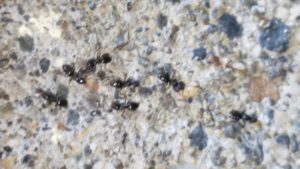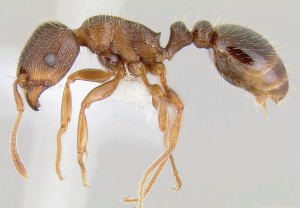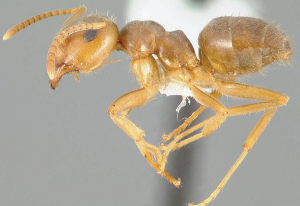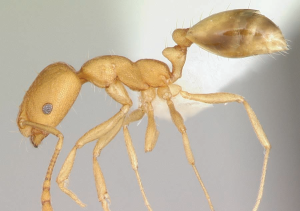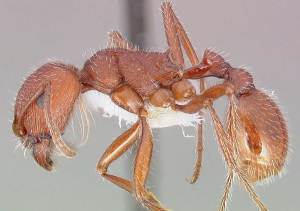Ants: Facts, Identification , Control and Extermination
In seattle king county, washington the most common ants that infest in homes or commercial buildings are the pavement ants. Ants are social insects that typically live in underground colonies, made up of workers and a queen. Ants will eat practically any kind of food, but are especially attracted to sweets. Ants are easily identifiable due to their three distinct body region: head, thorax and abdomen, as well as antennae.
When pest control or ant exterminators is treating for Pavements ants commonly know as little black sugar ants or house ants who got their name due to their habit of nesting in lawns,under pavement slabs(drive ways,sidewalks,rocks),building foundations.They are not destructive to building but they could contaminate food which could by a health hazard.
Sugar ants, Sidewalk ants, or pavement ants, are familiar to everyone. They are commonly seen during summer months on driveways, patio slabs, and walkways. They will sometimes be seen pushing piles of sand and other debris from cracks and from along slab edges. There are many different species, of different size and appearance.
Carpenter ants reside both outdoors and indoors in moist, decaying or hollow wood. They carve “galleries” into the wood grain to provide passageways for movement from section to section of the nest. They leave what looks like sawdust behind which provides an indication to where they are nesting.
Workers are 4 to 4.5 mm long and yellow in color. When crushed, they produce a lemon scent that is often described as citronella. When moisture ants move indoors, they often nest in wood that is moisture damaged. They frequently find damaged wood in areas like bath traps. They sometimes nest inside walls where there is a plumbing leak. There have been cases of these ants nesting in damp soil in crawlspaces. In these situations, the workers made mounds of excavated soil in the crawl space.
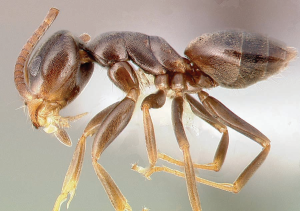 Odorous House Ants (Sugar Ants)
Odorous House Ants (Sugar Ants)
Odorous house ants can be very annoying as they frequently establish trails in your house along kitchen counters, cabinets, sinks, and baseboards in their search for food. They can also be difficult to eradicate, since there can be several (or many) queens in several locations, the workers can all trail together regardless of their home colonies, and the colonies frequently move from place to place, both inside and outside
Thatch ants are a large ant, sometimes confused with carpenter ants. They have a distinctive red head, which carpenter ants do not. Primarily an outside ant, they will occasionally invade structures. Most species of thatching ants are bicolored red and black .A few are all black. They are medium to large ants, averaging from 4–8 mm (3/16–5/16 inch) long, with a notch or depression on the top of the thorax when viewed from the side. They are polymorphic, that is, the workers vary in size within the same colony. Their reproductive swarms (winged males and queens leaving the colony) occur in late summer to early fall.
Pharaoh ant infests almost all areas of a building where food is available and infests many areas where food is not commonly found. Pharaoh ants have a wide preference in the types of food consumed. In infested areas, if sweet, fatty, or oily foods are left uncovered for only a short period of time, one can likely find a trail of Pharaoh ants to the food. As a consequence, they cause much food to be discarded due to contamination. Also called, and miscalled, sugar ants, grease ants, kitchen ants, and house ants.
The harvester ant behavior differs between each species, seen through their feeding and nesting habits. In addition, unlike many other ants that infest indoor structures, all species of harvester ants prefer not to invade houses and buildings, but will establish their nests around gardens or yards, often destroying vegetation.
The red harvester ants can be aggressive. They deliver a painful sting. Sometimes, the stings of harvester ants can cause allergic reactions, especially to those sensitive to their venom. Aside from their powerful stings, harvester ants also bite viciously
Velvety tree ants make their nest in the crooks of trees. Depending on the location, they nest in oaks, sycamores, cottonwoods, and pines. They also nest in the soil under rocks and inside logs or stumps. Colonies are usually very large. Normally the entire colony nests in the same place. However, sometimes there are satellite colonies and the workers move back and forth between the nests.
Velvety tree ants eat honeydew, nectar, and insects. They tend small insects, like aphids, because they produce honeydew. It is common to see velvety tree ant workers moving around in lines or trails on the trunks of trees. They often use tree limbs and branches to enter homes and other structures.
When they move indoors, velvety tree ants often make their nests inside wall voids. The workers often build paper-like nests inside the wall voids. They also hollow out sheetrock and foam insulation for nesting and passages. If they find damp, decaying wood, they hollow it out to nest inside.
Crushing a velvety tree ant worker, it releases an unpleasant odor. The workers also give off that odor if the colony is disturbed. The workers do not sting, but they bite if the nest is disturbed.
Over 30 years experience in pest control serving areas around Seattle, Auburn, Bellevue,Bothell, Burien, Carnation,Covington, Des Moines, Edmonds, Everett, Fall City, Federal Way,Goldbar, Issaquah, Juanita, Kirkland, Kenmore, Kent, Lake Forest Park, Lake Stevens,Lynnwood, Maltby, Maple Valley, Mercer Island, Mill Creek, Monroe, Mukilteo, Newcastle,Normandy Park, North Bend, Preston,Redmond, Renton, Richmond Beach, Sammamish,Seatac, Shoreline, Snohomish, Snoqualmie, Startup, Sultan, Tukwila,Tacoma,puyallup,Woodinville, Snohomish County, and King County. We understand and will control any issues regarding ants . Don’t forget we need ants in the system but not in your living spaces
